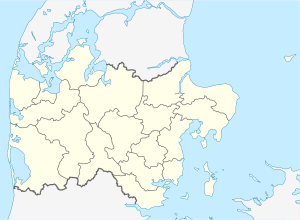Fur (island)
| For | ||
|---|---|---|
| Waters | Limfjord | |
| Geographical location | 56 ° 49 '54 " N , 9 ° 1' 27" E | |
|
|
||
| length | 8.2 km | |
| width | 5.3 km | |
| surface | 22.29 km² | |
| Highest elevation | Lille Jenshøj 76 moh |
|
| Residents | 767 (January 1, 2020) 34 inhabitants / km² |
|
| main place | Nederby | |
| Moler formation in a cliff section on Fur | ||
Fur (ancient: Fuur ) is a 22.29 square kilometer island with 767 inhabitants (January 1, 2020) in the Limfjord in the north of Jutland ( Denmark ). From the mainland (East Salling), Fur can be reached in three minutes by ferry across the 400 meter wide Fursund. Fur forms its own parish community Fur Sogn , which originally belonged to Harde Harre Herred in Viborg Amt . In 1970 she came to Sundsøre Kommune in what was then Viborg Amt and since the local reform on January 1st 2007 to Skive Kommune in the Midtjylland region . Fur is a member of the Danish Small Island Association .
Today Fur is a typical holiday home island and accommodates over 1000 summer guests. Other branches of activity are agriculture with black sandy fields, mussel fishing and the moler industry . Moler is a clay-like, very light mineral that is important, among other things, in the refractory construction of industrial furnace systems.
The island is flat in the south and gently rises towards the north to the cliff. There you can see the preferred wind direction of the trees that were only planted less than a hundred years ago. Previously a heathland dominated here .
The island is of outstanding geological interest. In the vast majority of Moler constructed steep coast in the north of the island the entire layer sequence of Moler with numerous ash layers (Fur-formation from the Lower nearly Eocene ) open-minded. This site is also a type locality of the Eocene sea turtle Tasbacka danica (Karl & Madsen 2012). In the moler, which also appears in other places in the Limfjord area , some spectacular fossil finds have been made, some of which are on display in the Fur Museum ( Nederby ). A curiosity can be found in the section of the cliff called the Stolleklint . The name goes back to the fact that at the beginning of the 19th century it was assumed that the dark layers of ash in the moler consisted of carbonaceous sand. In the hope of being able to mine coal, Swedish prisoners of war drove a 50 meter deep tunnel into the rock and an equally deep shaft at the end of this tunnel. It was only much later, around 1900, that Belgian geologists succeeded in elucidating the actual composition of the dark ash layers, consisting of quartz sand and volcanic ash dust. The tunnel has collapsed, but its entrance in the cliff can still be seen.
Also worth seeing is the section roughly in the middle of the north coast between Stolleklint and Østklint , where the so-called Rødsten (Rotstein) occurs. It is meltwater sand and gravel that is cemented together by iron compounds that come from the moler leached sulfur gravel . These iron compounds give the Rødsten its striking red color. The apse and part of the nave of the Fur Church in Nederby are made of red stone.
The highest point on the island is now Lille Jenshøj with 76 moh , after the originally highest Bette Jenses Hyw was removed in 1962.
The island has somewhat rocky beaches, but you can swim in the Limfjord.
The villages of Nederby (with 75 percent of the island's population), Stenøre , Madsbad , Hvirp and Debel are located on Fur . Many farmers live here on repatriate farms.
The Stendalhøje (5) and the Smediehøje (4) are grave hill on the island. The Emmelsten Langdysse (also called Kæmpegrav or Kjæmpegraven ) is located in the north of the island.
literature
- HV Karl, H. Madsen: Tasbacka danica n. Sp., A new Eocene marine turtle of Denmark (Testudines: Chelonioidea) . - Studia Palaeocheloniologica 4 (2012) S, 193-204.
- Karsten Kjer Michaelsen: Politics bog om Danmarks oldtid . Copenhagen 2002 ISBN 87-567-6458-8 , p. 85
- Steen Andersen & Steen Sjørring (eds.): Det nordlige Jylland (published as the third of five volumes in the Geologisk set series ). 208 p., Numerous Fig. And maps, Geografforlaget, Brenderup (DK) 1997 (2nd edition of the 1st edition).


